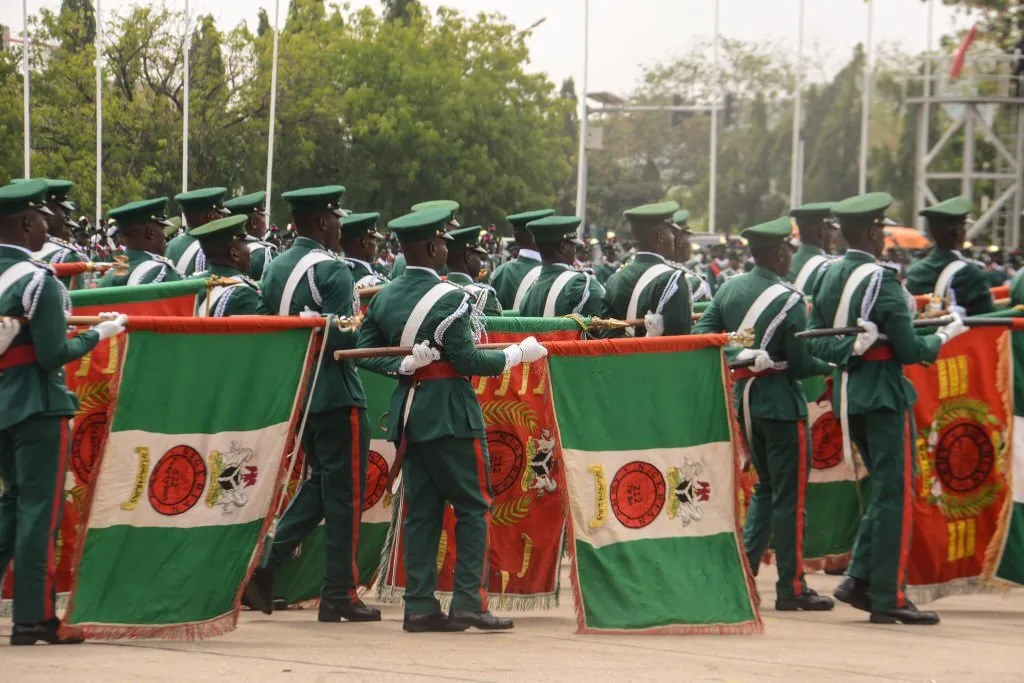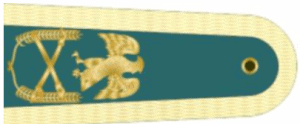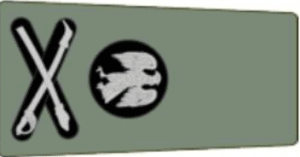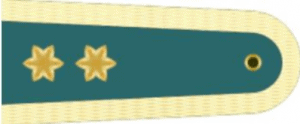The Structure of the Nigerian Military
Let’s use some lines to talk about the Nigerian military in general before we dive into the list of the Nigerian army ranks. It took its present form in 1960, the same year that Nigeria had its independence.
It is the duty of the military to guide the Nigerian people from internal and external dangers and to uphold the country’s structural integrity.
Branches of Nigerian Armed Forces
- Nigerian Army which is responsible for maintaining peace on the land, enforcing the law, and controlling humanitarian missions;
- Nigerian Navy which operates in the open waters to assure the security of the country and offer rescue if necessary
- The Nigerian Airforce which provides air support, cargo transportation, and other air missions
The Nigerian Army was formed in 1960 and is the Nigerian Armed Forces’ foremost defensive arm, responsible for land warfare. It is commanded by the Nigerian Army Council (NAC). The original elements of the Royal West African Frontier Force (RWAFF) in Nigeria were formed in 1900.
Meanwhile, on the verge of the War, British-trained Nigerian troops saw action with the 1st (West Africa) Infantry Brigade, the 81st, and the 82nd (West Africa) Divisions are the ones that fought in the East African Campaign (World War II) and in the Far East.
More Details
In Nigeria, from a force of 18,000 in infantry battalions and supportive units, strength came forth around 126,000 in three divisions by the end of the Nigerian Civil War in 1970.
Interestingly, in the sphere of doctrine, the work of the Federal Nigerian army did not basically change: its task continued to remain close to and conquer an organized enemy.
The effect of individual personalities is basically greater in the armies of developing states, as they tend to have weaker institutional frameworks.

However, the main personalities involved in Nigeria included then-Colonel Olusegun Obasanjo. Obasanjo is principally significant owing to his moves to reorder his command 3 Division during the civil war to foster its logistics and administration.
The reorganization he rated made the Division able of doing its task which ended the civil war.
Moreover, the Nigerian Army fought the Civil War significantly with fewer resources. Obasanjo’s memoirs chronicle the lack of any stocks of extra equipment for mobilization and the “haphazard and unreliable system of procurement and provisioning” which lasted for the entire period of the war.
Arms embargoes imposed by various Western countries made the situation more difficult.
Nigerian Army Ranks
Let’s look at Nigerian army ranks and their symbols:
1. Field Marshal
The field marshal is another name for General of the Army, it is the highest rank in the Nigerian Army but unfortunately, no personnel since the creation of the Nigerian Army have ever reached up to this rank.
As shown above, The insignia of the Field Marshal is made up of a golden eagle, a cross of sword, and a baton surrounded by two branches.
2. General
The second after the field marshal is the General and so far in Nigeria, it is the highest attained rank in the Nigerian Army, a General is identified by a silver eagle, two golden six-pointed stars, and a cross of sword and baton.
3. Lieutenant General
The third in this category is the Lieutenant General. He is the third most powerful rank in the Nigerian Army. Its symbol is composed of all elements making up the symbol of Major General, and a golden six-pointed star.
4. Major General
Major General is the second rank from the bottom in the powerful phase of ranks in the Nigerian Army. As shown above, The symbol of Major General is made up of a golden eagle and a cross of sword and baton
5. Brigadier
Brigadier is the lowest ranking general officer in the Nigerian Amy. When the Brigadier is been appointed to a field command, he is typically in command of a brigade consisting of around 4,000 troops.
liken to that of a Colonel, the insignia of a brigadier is made up of one silver eagle and six-pointed stars arranged in a triangular form.
6. Colonel
Colonel is among the top ranks in the Nigerian Army. And he plays the crucial duty to be responsible for the regiment (A regiment is a permanent unit of an army). The insignia for Colonel is one silver eagle above vertically aligned two six-pointed stars.
7. Lieutenant Colonel
Lieutenant Colonel is one of the most important ranks in the Nigerian Army, and becoming one is not an easy feat. The insignia for this rank is made up of one silver eagle above a vertically aligned six-pointed star below.
8. Major
In the order of the Nigerian Army, the rank of Major is next after the Captain. It is likened to the naval rank of lieutenant commander in the other uniformed services.
They can be identified by a “silver eagle” marked on the badge of their uniform.
9. Captain
This is undoubtedly the most famous in the rank within the army as it is known by both the learned and unlearned. And as we have said before, First Lieutenant and Second Lieutenant are subordinate to the Captain. The insignia of a Captain is made up of three six-pointed stars that are vertically aligned.
10. First Lieutenant
Next, after the Second Lieutenant, the First Lieutenant. And just as the Second Lieutenant is the second subordinate of a captain, the First Lieutenant is the Captain’s first substitute.
You can differentiate a First Lieutenant from a second lieutenant by looking out for the “vertically aligned two six-pointed stars” marked badge on the uniform.
11. Second Lieutenant
As the Lance Corporal, Second Lieutenant is the lowest rank in the hierarchy of commissioned officers. The word as used ‘lieutenant’ means substitute, and Second Lieutenant means the second substitute of a Captain.
It is easy to identify them as the insignia designated to this rank is a single “six-pointed star”, the star seen in the Nigerian Army emblem.
12. Master Warrant Officer
However, Master Warrant Officer also known as Master Sergeant, Master Warrant Officer is the highest non-commissioned rank in the Nigerian Army.
They are charged to deal with military equipment and can be identified by an insignia that has the “Nigerian coat of arms.“
13. Warrant Officer
The warrant officer is the next in line of rank after Staff Sergeant in the order of the Nigerian Army. It is thought to be a good rank for young military personnel.
As shown above, A Warrant Officer can be identified by the “golden eagle surrounded by a golden crown made of olive leaves” marked badge on the uniform.
14. Staff Sargent
Staff Sergeant is next after Sergeant; but unlike the Sergeant, a Staff Sergeant is a superior non-commissioned officer in the Nigerian Army. Staff Sergeant can be identified by “a golden eagle above the triple V” marked badge on the uniform.
15. Sargent
The sergeant comes after Corporal in the order of the Nigerian Army. And although it is senior to both a Lance Corporal and Corporal, a Sergeant in the Nigerian Army is still a junior non-commissioned officer.
However, to identify a Sergeant, look out for the “triple V” marked badge on the uniform
16. Corporal
This is second to the last in the hierarchy of Rank, the Corporal is the next rank that a Lance Corporal assumes upon promotion.
17. Lance Corporal
Although Lance Corporal is the lowest rank in the Nigerian Army, a soldier of this rank ranks higher than private soldiers (Privates are the newly recruited soldiers).
CSN Team.














